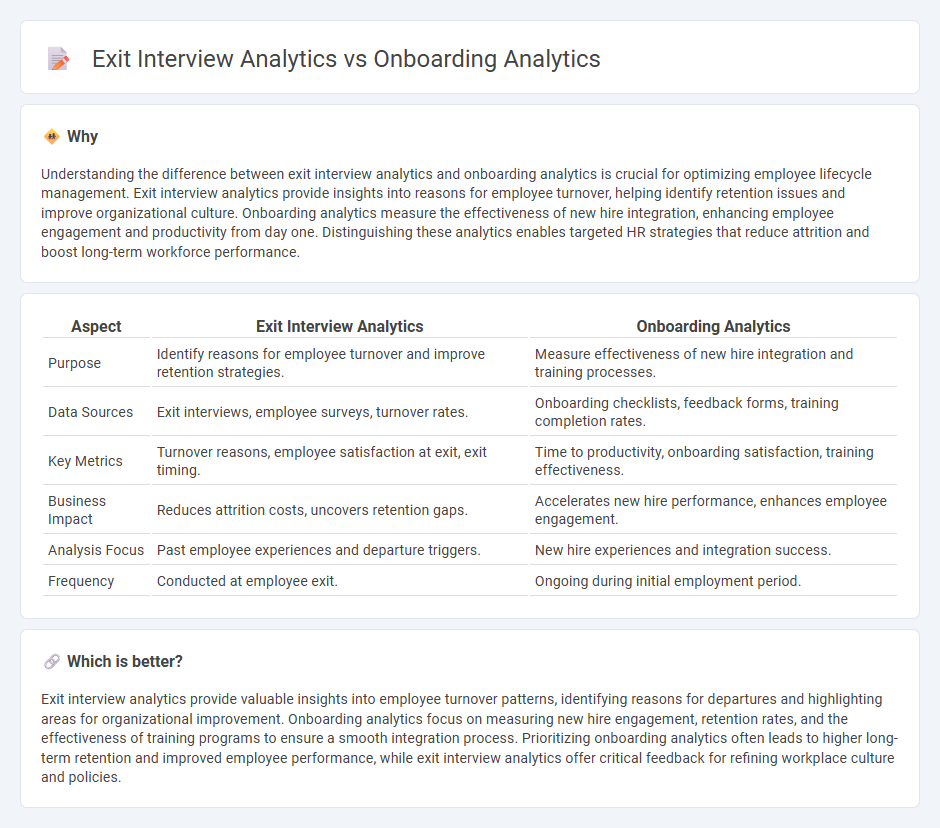
Exit interview analytics focus on gathering and analyzing data about employee departures to identify patterns, reasons for turnover, and areas for organizational improvement. Onboarding analytics measure the effectiveness of new hire integration by tracking engagement, training progress, and early performance indicators to enhance retention and productivity. Explore how leveraging both analytics can optimize workforce strategies and strengthen employee lifecycle management.
Why it is important
Understanding the difference between exit interview analytics and onboarding analytics is crucial for optimizing employee lifecycle management. Exit interview analytics provide insights into reasons for employee turnover, helping identify retention issues and improve organizational culture. Onboarding analytics measure the effectiveness of new hire integration, enhancing employee engagement and productivity from day one. Distinguishing these analytics enables targeted HR strategies that reduce attrition and boost long-term workforce performance.
Comparison Table
| Aspect | Exit Interview Analytics | Onboarding Analytics |
|---|---|---|
| Purpose | Identify reasons for employee turnover and improve retention strategies. | Measure effectiveness of new hire integration and training processes. |
| Data Sources | Exit interviews, employee surveys, turnover rates. | Onboarding checklists, feedback forms, training completion rates. |
| Key Metrics | Turnover reasons, employee satisfaction at exit, exit timing. | Time to productivity, onboarding satisfaction, training effectiveness. |
| Business Impact | Reduces attrition costs, uncovers retention gaps. | Accelerates new hire performance, enhances employee engagement. |
| Analysis Focus | Past employee experiences and departure triggers. | New hire experiences and integration success. |
| Frequency | Conducted at employee exit. | Ongoing during initial employment period. |
Which is better?
Exit interview analytics provide valuable insights into employee turnover patterns, identifying reasons for departures and highlighting areas for organizational improvement. Onboarding analytics focus on measuring new hire engagement, retention rates, and the effectiveness of training programs to ensure a smooth integration process. Prioritizing onboarding analytics often leads to higher long-term retention and improved employee performance, while exit interview analytics offer critical feedback for refining workplace culture and policies.
Connection
Exit interview analytics and onboarding analytics are interconnected through their focus on employee lifecycle insights, revealing patterns in turnover causes and new hire integration challenges. Data from exit interviews identifies reasons for employee departures, which onboarding analytics use to refine training and engagement strategies, reducing future attrition. This connection enables HR departments to implement targeted improvements, enhancing employee retention and organizational performance.
Key Terms
**Onboarding Analytics:**
Onboarding analytics tracks new employee engagement, productivity, and retention metrics during the initial employment phase, using data from surveys, performance assessments, and training completion rates to optimize integration processes. It identifies patterns in early attrition and highlights areas for improving orientation programs and cultural fit. Discover how deeper onboarding analytics can significantly enhance your workforce retention strategies.
Time-to-Productivity
Onboarding analytics measures the time-to-productivity by tracking how quickly new hires acquire necessary skills and contribute to business goals, while exit interview analytics identifies factors that may have delayed productivity or led to employee turnover. Effective use of onboarding data can shorten ramp-up periods, enhancing retention and performance metrics. Discover how integrating both analytics can optimize workforce efficiency and reduce costly delays.
New Hire Engagement
Onboarding analytics measures new hire engagement by tracking metrics such as time-to-productivity, training completion rates, and early feedback scores, providing insights into how well employees acclimate to their roles. Exit interview analytics, conversely, sheds light on disengagement factors through employee reasons for leaving, dissatisfaction patterns, and turnover trends. Explore more about leveraging both analytics to enhance workforce retention and engagement strategies.
Source and External Links
Onboarding Software Analytics: Key Metrics for Success | HR Cloud - Onboarding analytics focuses on measuring key metrics such as time-to-productivity and completion rates of onboarding modules to optimize user onboarding, reduce churn, and increase retention effectively.
IT Onboarding Analytics: 8 Key Metrics to Track for Success - IT onboarding analytics use data on time-to-productivity, retention rates, training completion, and employee engagement to enhance the onboarding experience and reduce turnover.
User Onboarding & Customer Onboarding Metrics - How to Guide - User onboarding analytics help businesses track performance through key KPIs to improve engagement and retention early in the product adoption process by analyzing user behavior and onboarding efficiency.
 dowidth.com
dowidth.com